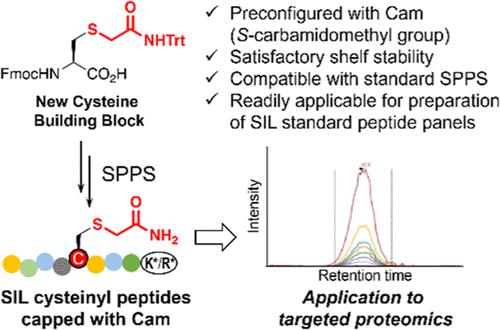当前位置:
X-MOL 学术
›
Anal. Chem.
›
论文详情
Our official English website, www.x-mol.net, welcomes your
feedback! (Note: you will need to create a separate account there.)
Synthesis of S-Carbamidomethyl Cysteine and Its Use for Quantification of Cysteinyl Peptides by Targeted Proteomics
Analytical Chemistry ( IF 6.7 ) Pub Date : 2023-09-14 , DOI: 10.1021/acs.analchem.3c02768 Suyeon Yeom 1 , Dowoon Nam 1 , Kwon Hee Bok 1 , Hye Kyeong Kwon 1 , Seungwoo Kim 1 , Sang-Won Lee 1 , Hak Joong Kim 1
Analytical Chemistry ( IF 6.7 ) Pub Date : 2023-09-14 , DOI: 10.1021/acs.analchem.3c02768 Suyeon Yeom 1 , Dowoon Nam 1 , Kwon Hee Bok 1 , Hye Kyeong Kwon 1 , Seungwoo Kim 1 , Sang-Won Lee 1 , Hak Joong Kim 1
Affiliation

|
Proteomics has played a central role in the identification of reliable disease biomarkers, which are the basis of precision medicine, a promising approach for tackling recalcitrant diseases such as cancer, that elude conventional treatments. Among proteomic methodologies, targeted proteomics employing stable isotope-labeled (SIL) internal standards is particularly suited for the clinical translation of biomarker information owing to its high throughput and accuracy in the quantitative analysis of patient-derived proteomes. Using SIL internal standards ensures the utmost level of confidence in detection and precision in targeted MS experiments. For successfully establishing assays based on targeted proteomics, it is crucial to secure broad coverage when selecting the SIL standard peptide panel. However, cysteinyl peptides have often been excluded because of cysteine’s high chemical reactivity. To address this limitation, a new cysteine building block was developed by incorporating a sulfhydryl group configured with an S-carbamidomethyl group, which is commonly used in proteome sampling. This compound was found to be chemically stable and applicable to a variety of solid-phase peptide synthesis (SPPS) campaigns. Furthermore, a direct comparison of the synthesized SIL peptides and tryptic endogenous peptides demonstrated the potential utility of an SPPS flow based on the new cysteine building block for improving the success of targeted proteomic applications.
中文翻译:

S-氨基甲酰胺甲基半胱氨酸的合成及其用于通过靶向蛋白质组学定量半胱氨酰肽的用途
蛋白质组学在识别可靠的疾病生物标志物方面发挥了核心作用,这些生物标志物是精准医学的基础,是解决传统治疗方法无法解决的顽固性疾病(例如癌症)的一种有前景的方法。在蛋白质组学方法中,采用稳定同位素标记 (SIL) 内标的靶向蛋白质组学特别适合生物标志物信息的临床翻译,因为它在患者来源的蛋白质组定量分析中具有高通量和准确性。使用 SIL 内标可确保对目标 MS 实验的检测和精度具有最高的信心。为了成功建立基于靶向蛋白质组学的检测方法,在选择 SIL 标准肽组时确保广泛的覆盖范围至关重要。然而,由于半胱氨酸的高化学反应性,半胱氨酰肽常常被排除在外。为了解决这一限制,我们开发了一种新的半胱氨酸结构单元,通过掺入由S-脲甲基配置的巯基,该结构常用于蛋白质组采样。该化合物化学性质稳定,适用于各种固相肽合成 (SPPS) 活动。此外,合成的 SIL 肽和胰蛋白酶内源肽的直接比较证明了基于新半胱氨酸构建块的 SPPS 流程在提高靶向蛋白质组学应用的成功率方面的潜在效用。
更新日期:2023-09-14
中文翻译:

S-氨基甲酰胺甲基半胱氨酸的合成及其用于通过靶向蛋白质组学定量半胱氨酰肽的用途
蛋白质组学在识别可靠的疾病生物标志物方面发挥了核心作用,这些生物标志物是精准医学的基础,是解决传统治疗方法无法解决的顽固性疾病(例如癌症)的一种有前景的方法。在蛋白质组学方法中,采用稳定同位素标记 (SIL) 内标的靶向蛋白质组学特别适合生物标志物信息的临床翻译,因为它在患者来源的蛋白质组定量分析中具有高通量和准确性。使用 SIL 内标可确保对目标 MS 实验的检测和精度具有最高的信心。为了成功建立基于靶向蛋白质组学的检测方法,在选择 SIL 标准肽组时确保广泛的覆盖范围至关重要。然而,由于半胱氨酸的高化学反应性,半胱氨酰肽常常被排除在外。为了解决这一限制,我们开发了一种新的半胱氨酸结构单元,通过掺入由S-脲甲基配置的巯基,该结构常用于蛋白质组采样。该化合物化学性质稳定,适用于各种固相肽合成 (SPPS) 活动。此外,合成的 SIL 肽和胰蛋白酶内源肽的直接比较证明了基于新半胱氨酸构建块的 SPPS 流程在提高靶向蛋白质组学应用的成功率方面的潜在效用。


















































 京公网安备 11010802027423号
京公网安备 11010802027423号